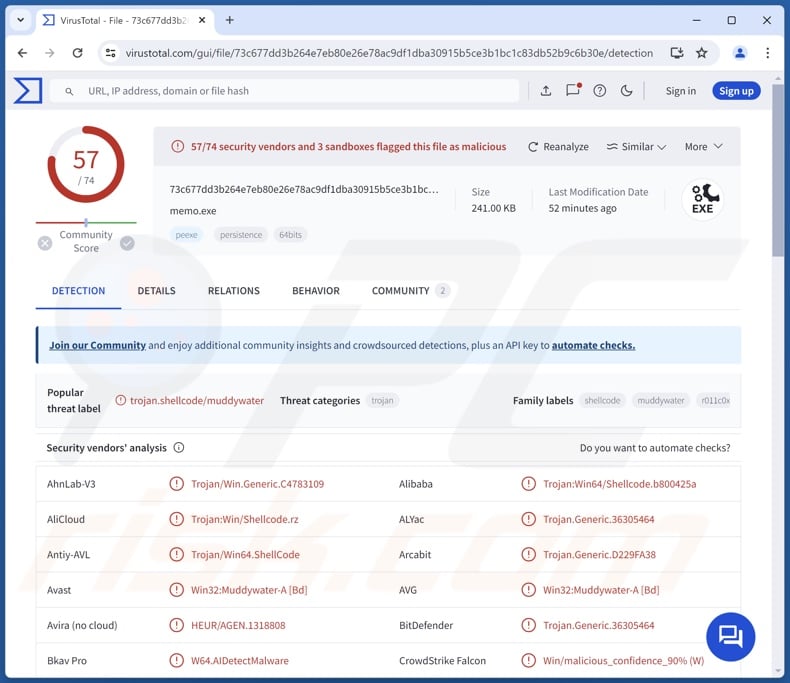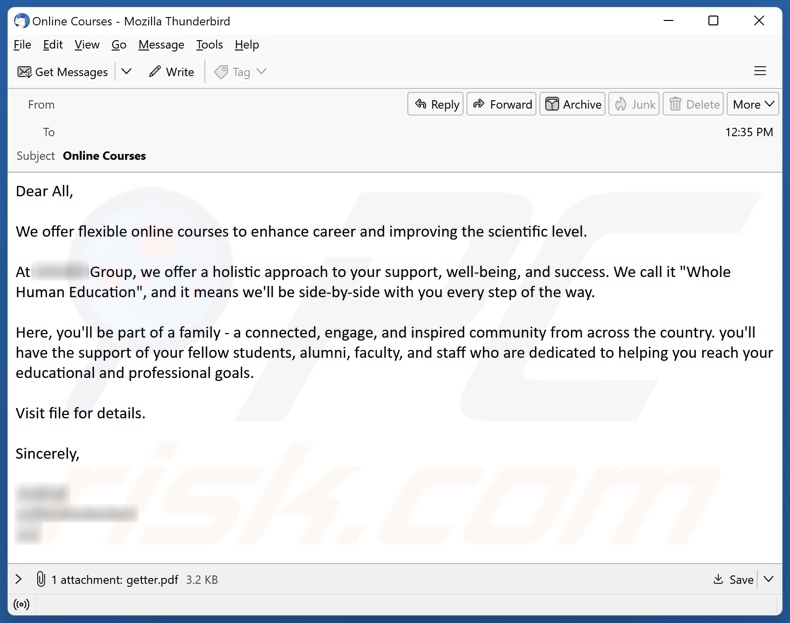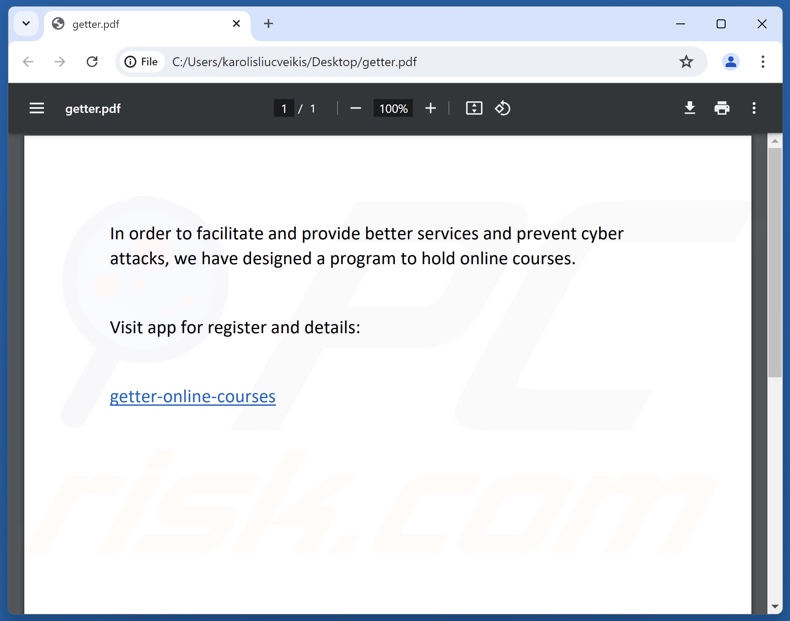Get free scan and check if your device is infected.
Remove it nowTo use full-featured product, you have to purchase a license for Combo Cleaner. Seven days free trial available. Combo Cleaner is owned and operated by RCS LT, the parent company of PCRisk.com.
What kind of malware is BugSleep?
BugSleep is the name of a backdoor-type malware. Malicious software within this category is typically used in the initial stages of infection to prep systems for further infiltration or to gather base data. BugSleep can execute a number of commands on devices and manipulate victims' files.
This malware is a custom-made backdoor that has been around since at least the spring of 2024. It is used by a threat actor called "MuddyWater"; this group is associated with the Ministry of Intelligence of the Islamic Republic of Iran (MOIS). BugSleep was first observed in an attack leveraged against a company based in Israel.

BugSleep malware overview
BugSleep has anti-detection and anti-analysis features, including detecting when executed in a sandbox environment. Following infiltration, this backdoor takes action to ensure persistence. It sets itself as a scheduled task, repeating every thirty minutes. The malicious program can also enter sleep mode, and some versions can alter this time of inactivity.
Additionally, BugSleep can inject its shellcode into legitimate processes, such as PowerShell, Microsoft Edge, Google Chrome, Opera, AnyDesk, and OneDrive. This program can execute commands and manage files by writing and downloading (stealing) them.
Malware developers commonly improve upon their software and methodologies, and evidence suggests that BugSleep is in active development. This backdoor has undergone bug (flaw) removal and includes unused code. Therefore, potential future iterations of BugSleep may be more streamlined or include additional/different features.
To summarize, the presence of software like BugSleep on devices can lead to multiple system infections, serious privacy issues, financial losses, and identity theft.
It must be mentioned that malware leveraged against high-sensitivity targets (as BugSleep has been) may pose threats of even greater significance.
| Name | BugSleep malware |
| Threat Type | Trojan, Backdoor |
| Detection Names | Avast (Win32:Muddywater-A [Bd]), Combo Cleaner (Trojan.Generic.36305464), ESET-NOD32 (A Variant Of Win64/Agent.YM), Kaspersky (Trojan.Win64.Shellcode.rc), Microsoft (Trojan:Win64/Donut.C!MTB), Full List Of Detections (VirusTotal) |
| Symptoms | Trojans are designed to stealthily infiltrate the victim's computer and remain silent, and thus no particular symptoms are clearly visible on an infected machine. |
| Distribution methods | Infected email attachments, malicious online advertisements, social engineering, software 'cracks'. |
| Damage | Stolen passwords and banking information, identity theft, the victim's computer added to a botnet. |
| Malware Removal (Windows) |
To eliminate possible malware infections, scan your computer with legitimate antivirus software. Our security researchers recommend using Combo Cleaner. Download Combo CleanerTo use full-featured product, you have to purchase a license for Combo Cleaner. 7 days free trial available. Combo Cleaner is owned and operated by RCS LT, the parent company of PCRisk.com. |
Backdoor-type malware examples
Warmcookie, NICECURL, TAMECAT, MadMxShel, and XRed are just some of our newest articles on backdoor-type malware.
As mentioned in the introduction, this type of software is usually implemented in the initial stages of infection. These programs can be used for prepping systems, scouting vulnerabilities, persistence-ensuring purposes, reconnaissance, and even downloading/installing additional malicious programs or content.
It must be emphasized that regardless of how malware operates – its presence on a system threatens device integrity and user safety. Therefore, all threats must be eliminated immediately upon detection.
How did BugSleep infiltrate my computer?
BugSleep has been noted being distributed via email spam campaigns (malspam). This is standard practice for the "MuddyWater" threat group, which is affiliated with MOIS. The BugSleep was used to target an Israeli company.
MuddyWater is incredibly active in the Middle East, but it has also run campaigns in countries outside this region. The group has used both targeted and generic lures in their malspam. This threat actor has made attempts to infect networks associated with airlines, travel agencies, news organizations, municipalities (Israel), and other entities.
At the very least, the email lures named the targeted organizations, but they varied in their themes (e.g., industry-specific software, online courses, webinars, etc.). Bait has also been reused; the same template was utilized in a Saudi Arabia campaign and against an Israeli company (the latter spreading BugSleep).
MuddyWater has sent out spam mail written in local languages and English. Typically, the malspam is sent out using stolen email accounts that are linked to the target.
To expand upon the campaign proliferating BugSleep, the emails included a PDF attachment containing a link, which led to the download of a ZIP archive. This file was hosted by abusing the Egnyte file-sharing service.
Egnyte is widely used in corporate settings to share files via the Web. The threat group in question has utilized Egnyte subdomains that incorporate the names of targeted entities, and when a webpage is opened – it can follow the naming fashion used by the target and include the appropriate sender.
The downloaded archive contained BugSleep's executable. This malware could then self-inject into genuine processes and go on to perform persistence-related activities before connecting to its C&C (Command and Control) server.
However, BugSleep could be distributed by relying on other methods. Cyber criminals predominantly rely on phishing and social engineering tactics to spread malware. Malicious programs are usually disguised as or bundled with regular content.
Virulent files come in various formats, e.g., archives (ZIP, RAR, etc.), executables (.exe, .run, etc.), documents (Microsoft Office, Microsoft OneNote, PDF, etc.), JavaScript, and so on. Once a malicious file is executed, run, or otherwise opened (e.g., clicking embedded links/files, enabling macros, etc.) – the infection chain is initiated.
Widespread distribution techniques include: malicious attachments/links in spam (e.g., emails, DMs/PMs, etc.), drive-by (stealthy/deceptive) downloads, online scams, malvertising, suspect download sources (e.g., freeware and third-party sites, P2P sharing networks, etc.), pirated content, illegal software activation ("cracking") tools, and fake updates.
What is more, some malicious programs can self-proliferate via local networks and removable storage devices (e.g., external hard drives, USB flash drives, etc.).
How to avoid installation of malware?
We highly recommend approaching incoming emails and other messages with caution. Do not open attachments or links found in dubious/irrelevant mail, as they can be malicious. Additionally, be vigilant while browsing since fraudulent and dangerous online content usually appears genuine and innocuous.
Another recommendation is to download only from official and verified channels. We advise activating and updating programs using functions/tools provided by legitimate developers, as those acquired from third-parties can contain malware.
It is paramount for device/user safety to have a reputable anti-virus installed and kept up-to-date. This software must be used to perform regular system scans and to remove threats and issues. If you believe that your computer is already infected, we recommend running a scan with Combo Cleaner Antivirus for Windows to automatically eliminate infiltrated malware.
Screenshot of a spam email proliferating BugSleep backdoor malware:

Text presented in this email letter:
Subject: Online Courses
Dear All,
We offer flexible online courses to enhance career and improving the scientific level.
At - Group, we offer a holistic approach to your support, well-being, and success. We call it "Whole Human Education", and it means we'll be side-by-side with you every step of the way.
Here, you'll be part of a family - a connected, engage, and inspired community from across the country. you'll have the support of your fellow students, alumni, faculty, and staff who are dedicated to helping you reach your educational and professional goals.
Visit file for details.
Sincerely,
-
Screenshot of the malicious attachment proliferating BugSleep ("getter.pdf"):

Instant automatic malware removal:
Manual threat removal might be a lengthy and complicated process that requires advanced IT skills. Combo Cleaner is a professional automatic malware removal tool that is recommended to get rid of malware. Download it by clicking the button below:
DOWNLOAD Combo CleanerBy downloading any software listed on this website you agree to our Privacy Policy and Terms of Use. To use full-featured product, you have to purchase a license for Combo Cleaner. 7 days free trial available. Combo Cleaner is owned and operated by RCS LT, the parent company of PCRisk.com.
Quick menu:
- What is BugSleep?
- STEP 1. Manual removal of BugSleep malware.
- STEP 2. Check if your computer is clean.
How to remove malware manually?
Manual malware removal is a complicated task - usually it is best to allow antivirus or anti-malware programs to do this automatically. To remove this malware we recommend using Combo Cleaner Antivirus for Windows.
If you wish to remove malware manually, the first step is to identify the name of the malware that you are trying to remove. Here is an example of a suspicious program running on a user's computer:

If you checked the list of programs running on your computer, for example, using task manager, and identified a program that looks suspicious, you should continue with these steps:
 Download a program called Autoruns. This program shows auto-start applications, Registry, and file system locations:
Download a program called Autoruns. This program shows auto-start applications, Registry, and file system locations:

 Restart your computer into Safe Mode:
Restart your computer into Safe Mode:
Windows XP and Windows 7 users: Start your computer in Safe Mode. Click Start, click Shut Down, click Restart, click OK. During your computer start process, press the F8 key on your keyboard multiple times until you see the Windows Advanced Option menu, and then select Safe Mode with Networking from the list.

Video showing how to start Windows 7 in "Safe Mode with Networking":
Windows 8 users: Start Windows 8 is Safe Mode with Networking - Go to Windows 8 Start Screen, type Advanced, in the search results select Settings. Click Advanced startup options, in the opened "General PC Settings" window, select Advanced startup.
Click the "Restart now" button. Your computer will now restart into the "Advanced Startup options menu". Click the "Troubleshoot" button, and then click the "Advanced options" button. In the advanced option screen, click "Startup settings".
Click the "Restart" button. Your PC will restart into the Startup Settings screen. Press F5 to boot in Safe Mode with Networking.

Video showing how to start Windows 8 in "Safe Mode with Networking":
Windows 10 users: Click the Windows logo and select the Power icon. In the opened menu click "Restart" while holding "Shift" button on your keyboard. In the "choose an option" window click on the "Troubleshoot", next select "Advanced options".
In the advanced options menu select "Startup Settings" and click on the "Restart" button. In the following window you should click the "F5" button on your keyboard. This will restart your operating system in safe mode with networking.

Video showing how to start Windows 10 in "Safe Mode with Networking":
 Extract the downloaded archive and run the Autoruns.exe file.
Extract the downloaded archive and run the Autoruns.exe file.

 In the Autoruns application, click "Options" at the top and uncheck "Hide Empty Locations" and "Hide Windows Entries" options. After this procedure, click the "Refresh" icon.
In the Autoruns application, click "Options" at the top and uncheck "Hide Empty Locations" and "Hide Windows Entries" options. After this procedure, click the "Refresh" icon.

 Check the list provided by the Autoruns application and locate the malware file that you want to eliminate.
Check the list provided by the Autoruns application and locate the malware file that you want to eliminate.
You should write down its full path and name. Note that some malware hides process names under legitimate Windows process names. At this stage, it is very important to avoid removing system files. After you locate the suspicious program you wish to remove, right click your mouse over its name and choose "Delete".

After removing the malware through the Autoruns application (this ensures that the malware will not run automatically on the next system startup), you should search for the malware name on your computer. Be sure to enable hidden files and folders before proceeding. If you find the filename of the malware, be sure to remove it.

Reboot your computer in normal mode. Following these steps should remove any malware from your computer. Note that manual threat removal requires advanced computer skills. If you do not have these skills, leave malware removal to antivirus and anti-malware programs.
These steps might not work with advanced malware infections. As always it is best to prevent infection than try to remove malware later. To keep your computer safe, install the latest operating system updates and use antivirus software. To be sure your computer is free of malware infections, we recommend scanning it with Combo Cleaner Antivirus for Windows.
Frequently Asked Questions (FAQ)
My computer is infected with BugSleep malware, should I format my storage device to get rid of it?
Malware removal rarely necessitates such drastic measures.
What are the biggest issues that BugSleep malware can cause?
The dangers posed by an infection depend on the malware's functionalities and the cyber criminals' modus operandi. BugSleep is a backdoor-type program capable of ensuring its persistence, executing commands, and stealing files.
Generally, such infections may result in multiple system infections, serious privacy issues, financial losses, and identity theft. It is noteworthy that BugSleep has been leveraged against high-sensitivity targets – and attacks of this kind may pose threats of greater significance.
What is the purpose of BugSleep malware?
Malware is primarily used to generate revenue. However, cyber criminals can also use malicious programs to amuse themselves, carry out personal vendettas, disrupt processes (e.g., websites, services, companies, organizations, etc.), engage in hacktivism, and launch politically/geopolitically motivated attacks.
It is pertinent to mention that BugSleep is associated with the Iranian Ministry of Intelligence and Security (MOIS), which suggests solid geopolitical motivations.
How did BugSleep malware infiltrate my computer?
BugSleep has been distributed via malspam (malicious spam campaigns). Other proliferation methods are not unlikely.
Malware is primarily spread through drive-by downloads, online scams, malvertising, untrustworthy download sources (e.g., freeware and free file-hosting websites, P2P sharing networks, etc.), pirated content, illegal software activation tools ("cracks"), and fake updates. Some malicious programs can even self-proliferate via local networks and removable storage devices.
Will Combo Cleaner protect me from malware?
Yes, Combo Cleaner is capable of detecting and eliminating nearly all known malware infections. It must be stressed that performing a full system scan is paramount since high-end malicious software usually hides deep within systems.
Share:

Tomas Meskauskas
Expert security researcher, professional malware analyst
I am passionate about computer security and technology. I have an experience of over 10 years working in various companies related to computer technical issue solving and Internet security. I have been working as an author and editor for pcrisk.com since 2010. Follow me on Twitter and LinkedIn to stay informed about the latest online security threats.
PCrisk security portal is brought by a company RCS LT.
Joined forces of security researchers help educate computer users about the latest online security threats. More information about the company RCS LT.
Our malware removal guides are free. However, if you want to support us you can send us a donation.
DonatePCrisk security portal is brought by a company RCS LT.
Joined forces of security researchers help educate computer users about the latest online security threats. More information about the company RCS LT.
Our malware removal guides are free. However, if you want to support us you can send us a donation.
Donate
▼ Show Discussion